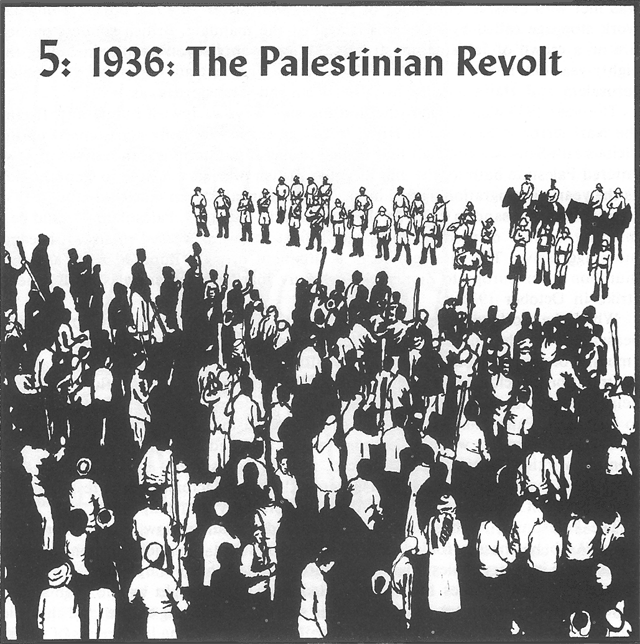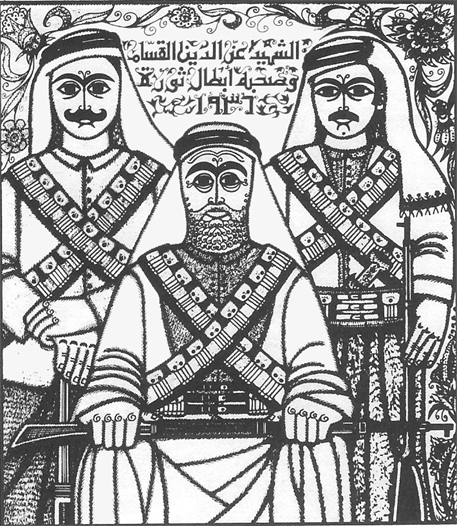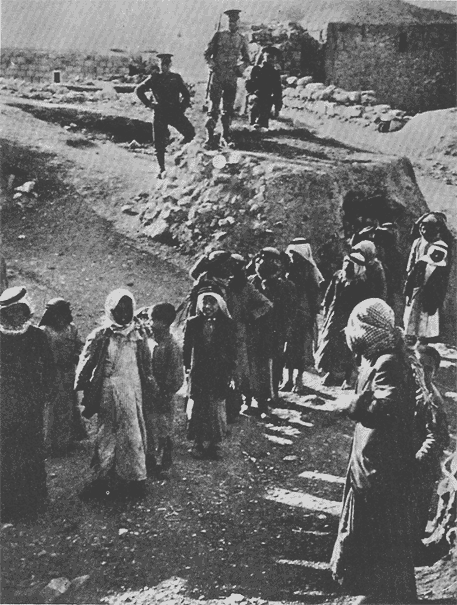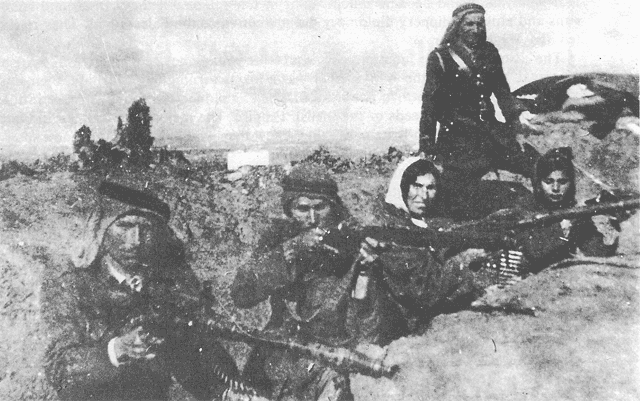Our Roots Are Still Alive - Chapter 5
Previous: Chapter 4
Table of Contents
Next: Chapter 6
New Jersey Solidarity-Activists for the Liberation of Palestine Main Site

- Seize your rights,
Al-Qassem trod that path before you.
- Palestinian poet, 1936
After the 1929 uprising, Palestine simmered with rebellion from the quiet hamlets to the bustling cities. A popular song heard in the villages and towns urged the people to arm themselves. The refrain went, "revolt relieves all cares." The sixty Palestinian newspapers continued to criticize the British government for its callous disregard of the Palestinian people's desire for independence. The sentiments spread as a revival of poetry and song swept the country. Recent university graduates, unable to find jobs, used their energies to compose stirring manifestos against British colonialism. They began to organize and to join with peasants in small cells that trained for armed revolt against the British.
Palestinians were tired of continually petitioning the mandate government with demands the British had no intention of granting. The British claim of being "even-handed" with Jews and Arabs became an ironic joke, as every Palestinian protest was met with evasive diplomacy or ruthless repression. In 1933, during a one-day work stoppage called by Palestinians against the mandate, British soldiers opened fire on a crowd of Jaffa demonstrators, killing twenty-seven people, including the eighty-year-old head of the Arab Executive. Demonstrations spread to Nablus, Jerusalem and Haifa - and to Syria, Iraq and Transjordan as well.
The year 1933 also brought the first massive wave of Jewish immigrants fleeing the Nazi terror in Europe. As Hitler seized power in Germany and stepped up the vicious anti-Semitic campaign that helped propel him into office, thousands of Jews entered Palestine both legally and illegally. British officials did little to stem the tide as the yearly immigration figures increased dramatically from nine thousand in 1932 to sixty-one thousand in 1935. At this rate, within ten years, Palestinians would be a minority in their own country. As the Zionist colony increased in size, it became more aggressive. The interception of a shipment of eight hundred rifles and ammunition from Europe to Zionists in Tel Aviv sparked another Palestinian general strike in October 1935.
When the worldwide depression hit Palestine in 1935, Palestinian workers and peasants were the main victims. The Zionist economy was supported by large amounts of capital brought in by the wealthier German Jews and by international contributions, including a $2.5 million loan from England. This influx of money helped protect the Zionists from the effects of the depression. They used the money to buy more Palestinian land and to open new businesses. In 1935, Jewish wages went up 10 percent, while Palestinian wages declined at the same rate. Among women working in textiles or tobacco, Jewish wages were already higher than Palestinian wages by as much as 443 percent! Jewish factory owners responded to the depression by laying off any Arab workers they still employed.
The Palestinian Arab economy suffered a devastating blow in the depression years. Arab businesses folded and Arab workers lost their jobs in construction, mining and industry. Palestinian agriculture declined sharply. By 1936, as many as twenty thousand families had been evicted from land bought by the Zionists. At least half of the peasantry could no longer sustain themselves on the land they did farm. Drifting into the cities in search of work, most joined the large ranks of unemployed workers. Workers returned to their ancestral villages only to find the peasants starving. Increasingly, the anger of workers was matched by the rebelliousness of the peasants. When the British refused to allow a thousand unemployed workers to demonstrate in Jaffa in June 1935, the Federation of Arab Workers warned: "The government will soon have to give the workers either bread or bullets."1
"Die as Martyrs!"
On November 12, 1935, Sheik Izz ad-Din al-Qassem went into the hills of Galilee with twenty-five followers to issue the call for armed revolt against the British. Qassem had arrived in Palestine in 1921 as a seasoned fighter against French colonialism in Syria. After 1929 he patiently built cells of young people and peasants to prepare for the day when the Palestinian people would stand up against the British - not in spontaneous demonstrations, but in an organized uprising. He spoke for the misery of the peasants and the hopes of thousands of them went with him into the hills. Qassem was killed one week later by a British patrol; but his ideas were soon to spark a massive uprising of the people. He died uttering three words that echoed over Palestine, "Die as martyrs!" News of his death and final words spread quickly. Hundred upon hundreds of peasants and workers walked for miles, following his body to its burial ground.

The Palestinian fight against Zionist settlers and the British began to take new forms. Qassemite guerrillas struck in February, surrounding a Haifa orchard that enforced the "Jewish Labor" policy, and again in April, attacking a coach on the Tulkarm Road. Their killing of two Jews was countered by a Zionist raid that killed two Palestinian farmers. Zionists marched through Tel Aviv on April 16, shouting, "We want a Jewish Army!" They began a march on nearby Jaffa. The next day, Zionist squads picketed businesses that hired Arabs. On Sunday morning, Palestinians in Jaffa gathered before British headquarters demanding permission for a parade. They were turned down. An angry crowd swept through the streets, stoning cars and buses, moving towards Tel Aviv. The two cities, the ancient Palestinian city of Jaffa and the newly rising Tel Aviv, center of the emerging Jewish state, symbolized two conflicting goals for Palestine.
On April 19, a Jaffa committee called a general strike of Palestinians against the mandate government. It spread to almost every city - Tulkarm, Nablus, Jerusalem, Jenin, Haifa. Each town committee had slightly different demands, but at the forefront, one blazed out: "Independence for Palestine!" Everyone participated - trade unions, women's associations, sports clubs, Boy Scouts and the YMCA. Christian and Moslem alike rose up to say "No!" to British rule over Palestine. By April 22, Arab shops, businesses and markets were shut. Transportation and communication had ground to a halt. The nation was on strike and hopes were high.

Zionist night squad searches an Arab village.
The people who started the strike had little experience of national politics. For national coordination, they fell back on the leadership of the old wealthy families of the Arab Executive. It reorganized on April 25 as the Arab Higher Committee, under the leadership of Haj Amin El-Husseini, the Mufti or religious leader of Jerusalem. Independence remained the rallying cry, with a halt of Jewish immigration as the condition for any Palestinian negotiation with the British. The leaders of the Higher Committee mouthed the slogans that arose from the lives of their people, but they anticipated leading only a short strike. They viewed the strike as a means to enhance their bargaining power with the British and their role in a future Palestinian government.
The majority of the people of Palestine believed that the strike might bring them independence. The Syrian people had just won a promise of self-government from the French after a fifty-day strike. As soon as the Palestinian strike began, Committees for Palestine sprung up in Damascus, Beirut, Baghdad and Cairo. Palestinians welcomed this support from Arab countries and eagerly awaited the British response.
The mandate government's answer to the strike was immediate and harsh. It announced a substantial increase in the immigration quotas for Jews for the next month and ordered the cutting of all telephone and telegraph wires from Palestine to surrounding Arab countries. The long-term strategy for dealing with the strike was simple: force and more force. The High Commissioner announced that British soldiers were free to fire on demonstrators.
In quick succession, a strike by Haifa sailors and a demonstration by hundreds of women in Gaza defied the armed troops. The British decided to destroy the leadership of the strike. They ordered the round-up of all known Communists in Palestine to prevent any actions on May 1, International Workers' Day. Yet on that day, two thousand people demonstrated in Haifa. After the British arrested sixty-one key leaders of local committees, other people took up their tasks. British Emergency Regulations, rigidly enforced against Palestinians, led to punishments like these: "Five years hard labor for possessing twelve bullets; eight months for possessing a stick."2
Punishment of individuals could not stop the tide of rebellion. Entire cities and villages defied British control. The British turned their attention to breaking the backbone of the strike, the communities of Palestinian men, women and children. The levied collective fines and imposed collective punishments on troublesome villages. If British troops heard one shot fired from a house, they made the entire village suffer.
Jaffa, where the strike had begun, was the target of especially vicious treatment. Dockworkers, sailors and students led the city in militant confrontation. Their organizing center was the ancient walled city. British soldiers feared to enter its narrow winding streets, impenetrable to tanks and cars. In June, under the pretense of "urban renewal," the British sealed off the quarter and dynamited hundreds of houses, leaving thousands of people without shelter. Another thousand homes were blown up in a nearby village.
Martial Law in Palestine
That same June the British High Commissioner reported that Palestine was in a "state of incipient revolution." There was, he reported, "little control of lawless elements outside principal towns, main roads and railways."3 Over twenty-five hundred Palestinians had been arrested. Over a thousand had been killed.
In July, with the support of the Zionist colony, the British placed Palestine under martial law. They rushed more troops from England. Over twenty thousand troops patrolled Palestine, still failing to control a population of less than one million people. Ships arrived loaded with tanks and machine guns. The Royal Air Force began strafing the countryside. The British formed Zionist settlers into "night squads" to attack Palestinian villages. Members of the Haganah, the Zionist army that had flourished since 1929, got their first taste of war, crushing the Palestinian rebellion. In Europe, the Zionist leader Weizmann pledged that Palestine would not fall to "the forces of destruction, the forces of the desert."4 The Zionists threw their full weight behind the British.
The unrelenting fury of the British and the Zionists made the Arab Higher Committee doubt the wisdom of continuing the strike. As the peasants became more militant and organized in response to the British, Haj Amin and the other wealthy leaders sensed a challenge to their own positions and power. The strike had lasted much longer than they had bargained for, largely because the economy of mandate Palestine was kept alive by the Zionist settlers who continued to produce and sell goods.
Many Zionist workers willingly scabbed, taking over Arab jobs in the civil service, the ports and the railroads. When Arab strikers closed the port of Jaffa, Zionists built the port at Tel Aviv and expanded the Haifa port. With Palestinian agriculture at a standstill, fruits and vegetables from Jewish fields captured the export market.
The members of the Arab Higher Committee were not interested in sacrificing their own wealth and traveling the road of all-out revolution. They were relieved when, in the summer of 1936, Britain approached King Abdullah of Transjordan and King Ghazi of Iraq with a proposal that the kings intervene in the strike. The intervention of the British "client kings" might stop the spread of the Palestinian rebellion that threatened to sweep away all in its path - the British mandate government, Zionism and perhaps the traditional Palestinian leadership itself.
Many Palestinians opposed the kings' meddling in the strike. At a large demonstration in Jerusalem in August, fifteen newspapers that reported Abdullah's proposal for peace were burned. But the members of the Higher Committee, still the sole national coordinating body, exercised all their authority and power as heads of family clans and villages, as landlords and employers, to force an end to the strike. Finally, after a series of negotiations, the kings called upon the Higher Committee to end the strike. The Higher Committee obeyed gratefully. This betrayal by the Arab kings created bitter disappointment among the people which was expressed by the poet Abu Salma:
- Shame to such kings, if kings are so low
By God, their crowns are not fit to sole shoes
We are the ones who will protect our homeland and heal its wounds.5
Rebellion and Betrayal
The Palestinian general strike lasted six months, the longest general strike in the history of the Middle East or Europe. It was a high point of consciousness, sacrifice and unity in the history of the Palestinian people. But it rapidly became clear that none of the demands of the strike were to be met. Britain, with both the Zionists and the Arab kings on its string, refused to give Palestine independence.
Britain's new ploy, recommended by the Peel Commission of 1937, was to partition Palestine into a Zionist and a Palestinian state, with both areas dominated by Britain. Although the Zionists owned only a tiny percentage of the land, under this plan they would receive much of the most fertile land in the country. The Zionists accepted the proposal. David Ben-Gurion stated clearly that the acceptance of this plan was but a stepping stone to a larger Jewish state:
- No Zionist can forgo the smallest portion of the Land of Israel. The debate has concerned which of two routes would lead quicker to the common goal.6
Palestinians rejected the proposal. Guerillas assassinated the pro-Zionist Commissioner of the Galilee, who schemed to include the Arab Galilee in the Jewish state. Open warfare flared once again.
 Palestinian men and women take up arms in 1936.
Palestinian men and women take up arms in 1936.
The British began a wholesale roundup of Palestinian leaders and deported most of the Higher Committee. This tactic only added fuel to the revolt. By the summer, guerrilla warfare spread in the hills of Palestine and rebellion engulfed the whole country. Most of the fighters were peasants. The British began arresting anyone in town wearing a keffiyah, the traditional peasant scarf. In support of the peasants, townspeople donned keffiyahs and stopped carrying IDs so the British could not check where anyone lived.
Peasants took over some towns. A British general reported in September that "the situation was such that civil administration and control of the country was, to all practical purposes, non-existent."7 British offices in most cities were closed and British troops placed Jerusalem under a five-day siege. In a four-month period, the British dynamited five thousand houses, added a thousand more prisoners to the three thousand already in jail and executed one hundred forty-eight prisoners in Acre prison alone. Still, they could not crush the rebellion.
Confronted with the prospect of a prolonged Palestinian resistance, the British took a long, hard look at their situation in the Middle East. War with Hitler's Germany was fast approaching. Just as in World War I, Britain would need Arab help, Arab oil and secure shipping routes. This was not the time to be fighting the Arabs. Furthermore, the rebellion in Palestine was tying down one-third of all British troops. To avoid greater damage to its empire, Britain decided to turn once again to paper promises for the Palestinians.
The British White Paper of 1939 suddenly reversed Britain's twenty-year policy toward Palestine. It promised a ceiling on Jewish immigration - only a total of seventy-five thousand Jews would be admitted in the next ten years. It pledged some restrictions on Zionist land purchases. It included an extremely vague pledge that Palestine would become independent in ten years. But the turn-around from guns and tanks to slippery diplomacy did not convince the Palestinians. They rejected the White Paper.
The Zionists were unanimously angry at what they considered a British "betrayal." For them, the White Paper was a major turning point. Britain, their imperial sponsor for more than twenty years, had abandoned the Zionist cause in the face of more pressing needs of the British Empire. The majority of Zionists did not want an open break with Britain, but they knew they would have to find a new sponsor.
In the meantime, Zionists launched a campaign against the Palestinian community. They organized strikes, bombed Palestinian marketplaces and increased secret military training.8 They had learned from the Palestinian rebellion that the people of Palestine would never peacefully accept conquest. A strategy that had been imbedded in Zionism from the beginning became explicit: the native people would have to be driven from Palestine. J. Weitz, head of the Jewish Agency's Colonization Department, wrote in his diary in 1940:
- There is no room for both peoples together in this country... We shall not achieve our goal of being an independent people with the Arabs in this small country. The only solution is Palestine, at least Western Palestine [West of the Jordan River], without Arabs... And there is no other way but to transfer the Arabs from here to the neighboring countries, to transfer all of them: not one village, not one tribe should be left.9 [emphasis added]
In 1940, the Zionist movement, carefully nurtured by imperialism, faced a devastated Palestinian people. Twenty thousand Palestinians had been killed or wounded, and thousands jailed. Many of the best fighters and organizers, the most trusted leaders, were dead. The great rebellion was over, but it would not be forgotten. It would be chronicled by writers, analyzed by political leaders and passed on through stories told in the villages and towns.
As the Palestinians mourned their dead and tended to the wounded, events that would profoundly affect their future were unfolding in Europe and America. For the next several years, the actions of the Palestinians were eclipsed by the great struggle for power in the Middle East and elsewhere that was unleashed in the Second World War.
Footnotes
- PFLP Bulletin (September-October 1974), pp. 6-7.
- PFLP Bulletin (June 1975), pp. 6.
- High Commissioner telegram to CO, 2 June 1936 (CO 733/297/75156) cited by William Quandt, The Politics of Palestinian Nationalism, p. 35.
- Cited by Matiel E.T. Mogannam, The Arab Woman and the Palestine Problem (London: 1937), p.295.
- PFLP Bulletin (January-February 1975), p. 7.
- David Ben-Gurion in a speech at the 20th Zionist Congress, Zurich, Switzerland, 15 August 1937, cited by Childers, "The Wordless Wish," in The Transformation of Palestine, p. 178.
- General Haining, GOC, Report to War Office, 30 November 1938, paragraph 14; St. Anthony's College, Oxford, private papers collection, cited by William Quandt, The Politics of Palestinian Nationalism, p. 38.
- John and Hadawi, The Palestine Diary, 1:320-21.
- Joseph Weitz, Diaries and Letters to the Children (Tel Aviv: 1965), p. 181.